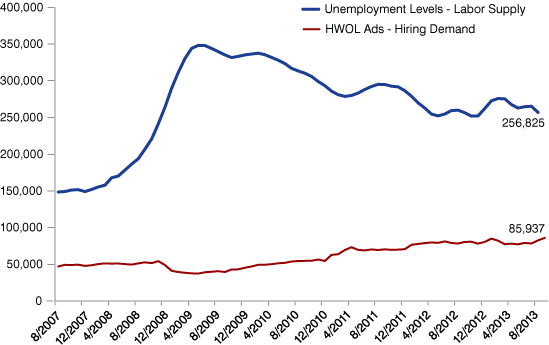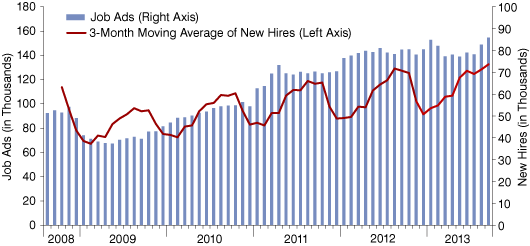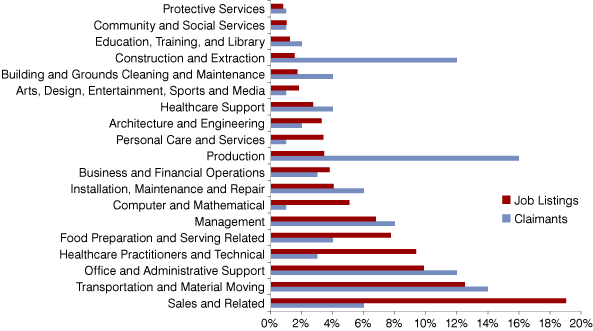Who's Hiring?
How can we measure labor supply and demand? There are growing numbers of non-governmental sources for informative labor market information and economic analysis. This article examines some of the key hiring demand indicators used by researchers and economic developers. The Indiana Department of Workforce Development (DWD) analyzes these data alongside its own Indiana Career Connect and Indiana Workforce Intelligence System (IWIS) data to better understand hiring demand.
Hiring Demand Indicators: Help Wanted OnLine and Wanted Analytics
Hiring demand, sometimes referred to as labor demand, has two parallel sources which are used to track and provide information regarding job vacancy postings all over the United States. The Help-Wanted OnLine (HWOL)® Data Series from The Conference Board1 is a job market vacancy listing that provides data collected from online job board sources throughout the nation. This series measures the number of “point in time” new, online job orders and jobs reposted from the prior month for over 16,000 job boards, corporate boards and smaller Internet sites that serve specialty job markets. These sources report middle of the month figures, to coincide with labor force estimates as reported by the U.S. Department of Labor.
WANTED Analytics™ began collecting detailed hiring demand data in June 2005 and is the exclusive data provider for the Help-Wanted OnLine Data Series, the monthly economic indicator of hiring demand in the United States. WANTED Analytics also uses web spidering technology to cull “real time” vacancy information from job boards across the country.
While online job postings only capture a small portion of the total economy and not every posting will result in a job vacancy filled, they can nevertheless be a leading indicator of future job growth in a given geographic area.
Comparison of the U.S., Indiana and Midwest
September 2013 help wanted ads in the United States were up by 209,700 (4 percent) over August 2013. Nationally, this is an increase of 304,305 ads (6 percent) since September 2012. The largest September gain was for food service workers, up 45,000. The number of ads for management positions also increased by 24,700 and transportation worker ads were up by 20,800. Hiring demand in the Midwest increased by 48,200 in September from August. Table 1 shows the data for select Midwestern states.
Table 1: Help Wanted Ads in Select Midwestern States, August 2013 to September 2013
| State | Change in Number of Ads | September Total Ads | Percent Change in Ads | Percent Change in Total Employment |
|---|---|---|---|---|
| Nebraska | 4,200 | 44,100 | 10.5% | 0.4% |
| Kansas | 3,100 | 46,700 | 7.1% | 0.2% |
| Minnesota | 5,900 | 122,900 | 5.0% | 0.2% |
| Iowa | 2,700 | 55,300 | 5.1% | 0.2% |
| Missouri | 3,600 | 85,600 | 4.4% | 0.1% |
| Indiana | 3,300 | 85,900 | 4.0% | 0.1% |
| Illinois | 7,500 | 204,500 | 3.8% | 0.1% |
| Michigan | 4,800 | 141,900 | 3.5% | 0.1% |
| Ohio | 3,400 | 197,500 | 1.8% | 0.1% |
| Wisconsin | 800 | 102,400 | 0.8% | 0.0% |
Note: Data are seasonally adjusted.
Source: The Conference Board and Help Wanted OnLine
Indiana’s online advertised vacancies rose 3,300 (4.0 percent) in September to an all-time series high of 85,937, seasonally adjusted (see Figure 1). This is an increase of 5,500 (7.0 percent) jobs posted in Indiana from September of last year, and slightly more than the national gains in advertised job ads. Optimistically we can hope this is a sign that Indiana employers are becoming less hesitant to fill new positions.
Figure 1: Indiana Monthly Online Job Openings, October 2012 to September 2013

Note: Data are seasonally adjusted.
Source: The Conference Board and Help Wanted OnLine
Figure 2 shows Indiana in August 2013 with 174,182 more unemployed than the number of advertised vacancies.2 This is down from 309,034 at the end of the recession in June 2009. Online ads for Indiana have increased by 45,205 or almost 110 percent during the same time period. The supply and demand rate in August stood at 3.1 unemployed Hoosiers for every posted vacancy. This has declined from a peak of 9.2 unemployed for every posted ad in the spring of 2009. The gap between hiring demand and labor supply as measured by these two sources began to increase in early 2008. This could have been an early indicator of the job losses ahead.
Figure 2: Indiana Labor Supply vs. Demand, August 2007 to August 2013

Source: The Conference Board, Help Wanted OnLine and the U.S. Bureau of Labor Statistics
Examining the job ads against a subset of new hires as reported to DWD also shows a consistent if non-surprising trend. The new hires charted as a rolling and lagged three-month average, follow the trend of job postings (see Figure 3). We can, therefore, make some general assumptions about job ads and future hiring. Throughout the recovery the trend has been positive and continues to climb.
Figure 3: Indiana Job Ads and New Hires, August 2008 to September 2013

Source: The Conference Board, Help Wanted OnLine; Indiana Department of Workforce Development and Indiana Workforce Intelligence System
Another promising figure is that the majority (58.7 percent) of jobs posted in September of 2013 were for full-time positions (see Table 2).
Table 2: Job Type Distribution, September 2013
| Job Type | Volume | Percent of Total |
|---|---|---|
| Full-Time | 50,457 | 58.7% |
| Part-Time | 17,456 | 20.3% |
| Contract | 8,260 | 9.6% |
| Internship | 481 | 0.6% |
| Unclassified | 9,283 | 10.8% |
| Total | 85,937 | 100.0% |
Source: The Conference Board, Help Wanted OnLine
Industry and Occupation
Industries with the highest volume of ads in September were retail trade; health care and social sciences; and administrative and support and waste management and remediation services (which includes temporary help agencies).
Sales and related occupations had the most total ads by major occupation group, followed by transportation and material moving occupations and healthcare practitioners and technical occupations. The last two occupation groups are also growth areas according to long-term employment projections by DWD.
Analysis of the Indiana Career Connect database reveals some of the gap between supply and demand. The Indiana Career Connect database is merely a subset of the possible labor pool (namely the unemployed population receiving unemployment benefits). However, Figure 4 indicates that there are far fewer trained and experienced unemployed workers available than in demand for personal care and service; computer and mathematical; healthcare practitioners and technical; as well as for sales and related occupations. Some key detailed occupations within these groups include engineers, database administrators, health diagnosing and treating practitioners, and services sales representatives. This does not represent the full available labor pool for Indiana, but it may give workforce professionals some indications of where the unemployed population may need additional training to transition to new employment.
Figure 4: Percent of Job Listings vs. Unemployed Claimants by Occupation Group, September 2013

Source: The Conference Board, Help Wanted OnLine; Indiana Department of Workforce Development, Indiana Career Connect
Occupational Coding to Better Determine Labor Supply
The Research and Analysis Division at DWD continues to seek new data to better understand Indiana's available labor pool. One critical data element that could benefit researchers is more thorough reporting of Standard Occupational Classification (SOC) codes.3 Having the SOC code for the unemployed claimant population helps us collect the occupational information shown in Figure 4. Yet we are missing this detail for most employer-reported data. These codes would allow for researchers to better analyze the skills and job functions of the workforce. Inclusion of the occupation codes within the IWIS longitudinal database already constructed, would allow researchers the ability to glean a better understanding of the skills gap and of the labor market in general. Indiana could then make more focused improvements in our educational systems and do a better job in designing training and curriculum to meet employer demand.
Notes
- Learn more about The Conference Board at www.conference-board.org/about/index.cfm?id=1980.
- September 2013 unemployment data for Indiana were not available due to the government shutdown.
- More information on SOCs can be found at www.onetonline.org/.
References
- The Conference Board, Help Wanted OnLine® (www.conferenceboard.org) and WANTED Analytics™ (www.wantedanalytics.com)
- U.S. Bureau of Labor Statistics (www.bls.gov/)
- Indiana Department of Workforce Development, Indiana Career Connect (www.indianacareerconnect.com)
- Indiana Workforce Intelligence System (https://indianaworkforceinformation.iu.edu/)
- Indiana Department of Workforce Development, Research & Analysis, Long Term Projections, 2010-2020 (www.hoosierdata.in.gov/dpage.asp?id=39&view_number=2&menu_level=smenu4&panel_number=2)
